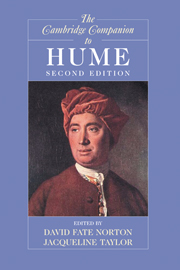Book contents
- Frontmatter
- 1 An Introduction to Hume’s Thought
- 2 Hume’s New Science of the Mind
- 3 Hume and the Mechanics of Mind: Impressions, Ideas, and Association
- 4 Hume’s Theory of Space and Time in Its Skeptical Context
- 5 Hume on Causation
- 6 Hume and the Problem of Personal Identity
- 7 Hume’s Skepticism
- 8 Hume’s Moral Psychology
- 9 The Foundations of Morality in Hume’s Treatise
- 10 Hume’s Later Moral Philosophy
- 11 The Structure of Hume’s Political Theory
- 12 Hume’s Principles of Political Economy
- 13 Hume on the Arts and “The Standard of Taste”: Texts and Contexts
- 14 David Hume: “The Historian”
- 15 Hume on Religion
- Appendix: Hume’s Autobiographies
- Selected Bibliography
- Index
- Series List
3 - Hume and the Mechanics of Mind: Impressions, Ideas, and Association
Published online by Cambridge University Press: 28 May 2009
- Frontmatter
- 1 An Introduction to Hume’s Thought
- 2 Hume’s New Science of the Mind
- 3 Hume and the Mechanics of Mind: Impressions, Ideas, and Association
- 4 Hume’s Theory of Space and Time in Its Skeptical Context
- 5 Hume on Causation
- 6 Hume and the Problem of Personal Identity
- 7 Hume’s Skepticism
- 8 Hume’s Moral Psychology
- 9 The Foundations of Morality in Hume’s Treatise
- 10 Hume’s Later Moral Philosophy
- 11 The Structure of Hume’s Political Theory
- 12 Hume’s Principles of Political Economy
- 13 Hume on the Arts and “The Standard of Taste”: Texts and Contexts
- 14 David Hume: “The Historian”
- 15 Hume on Religion
- Appendix: Hume’s Autobiographies
- Selected Bibliography
- Index
- Series List
Summary
By the time Hume started to work on his Treatise, the notion of an idea as the primary, most general sort of mental item dominated European philosophy. Although Descartes noted that, strictly speaking, only those “thoughts that are as it were images of things” were appropriately described as ideas, in practice he used “the word 'idea' to refer to whatever is immediately perceived by the mind.” Not only do we have ideas of trees and the sun, but we also have ideas of our own activities of thinking and willing. Locke characterizes “idea” as “being that Term, which, I think, serves best to stand for whatsoever is the Object of the Understanding when a Man thinks.” Locke also thinks that we not only have ideas that derive from things or objects in the world (ideas of sensation), but also of the activities and operations of our own minds (ideas of reflection). Ideas of sensation are acquired through the operation of external objects on our sense organs, while ideas of reflection come from introspection, from thinking about what happens within our own minds. He also thinks that these ideas of reflection are of two basic sorts of mental activity, perception and willing, that correspond to two faculties of mind: the understanding (or the power of thinking) and the will (or the power of volition).
- Type
- Chapter
- Information
- The Cambridge Companion to Hume , pp. 70 - 104Publisher: Cambridge University PressPrint publication year: 2008
- 4
- Cited by

